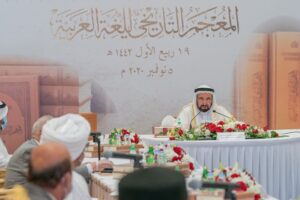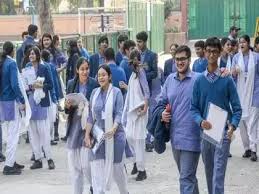SHARJAH: His Highness Sheikh Dr. Sultan bin Muhammad Al Qasimi, Member of the Supreme Council and Ruler of Sharjah, unveiled the first 8 volumes of The Historical Corpus of the Arabic Language marking an achievement for the culturally passionate emirate. It is the first-of-its-kind project to chronicle 17 centuries of development in the Arabic language, spanning five distinct time periods.
This achievement makes Sharjah the first city in the world to realize and bring to fruition more than 80 years’ worth of interrupted and incomplete efforts in the direction. The Sharjah Ruler had closely been involved and also directly supervised the project.
HH Sheikh Dr. Sultan Al Qasimi thanked everyone involved in the Historical Corpus of the Arabic Language project, particularly Dr. Hassan El Shafei, Chairman of Union of Arab Scientific Language Academies, and all other linguists and scholars at the union. He also thanked members of the Scientific Council, editors, linguists, and experts working in the Arabic Language Academy’s Executive Committee.

The Sharjah Ruler noted that the wealth of information in these volumes will enable Arab nations, academia and Arabic language enthusiasts to utilize lexical and semantic connotations, and its vibrant examples steeped in both historical and modern-day contexts.
Previous attempts to record the development of the Arabic language date back to 1936, when the Union of Arab Scientific Language Academies in Cairo began. It was led by a German orientalist and Arabist named Fisher. The process was stalled shortly after the completion of some of the entries of the first letter (hamzah).
The newly-revealed 8 volumes document the original root of words and outline their evolution throughout five distinct time periods in history: The pre-Islamic period, the Islamic era, the Abbasid Caliphate, the development of nation-states, and the modern-day era.
Under the supervision of the Union of Arab Scientific Language Academies in Cairo, Egypt, and with the Arabic Language Academy in Sharjah managing the project’s executive committee, hundreds of senior researchers and linguists, editors, and experts from 10 Arabic language academies across the Arab world is working to finish the entire corpus within an estimated timeframe of six years.
The project is also digitizing nearly 20,000 Arabic books, manuscripts, sources, and historical documents, including old inscriptions and archaeological finds, dating back to the third century before Islam. The corpus is unique as it focuses on the use of living language, and cites usages in quotes from the Holy Quran, the Hadith as well as from poems, speeches, letters, and other sources.
The development of Arabic words used through the centuries is traced in the volume. It also documents the entry of new words into the lexicon, and also lists words no longer in use explaining the reasons for it. Semantic changes that have influenced the Arabic language across all five time periods under the corpus’s purview are also detailed in the volume.
































